
by Timothy Oleson Tuesday, April 7, 2015
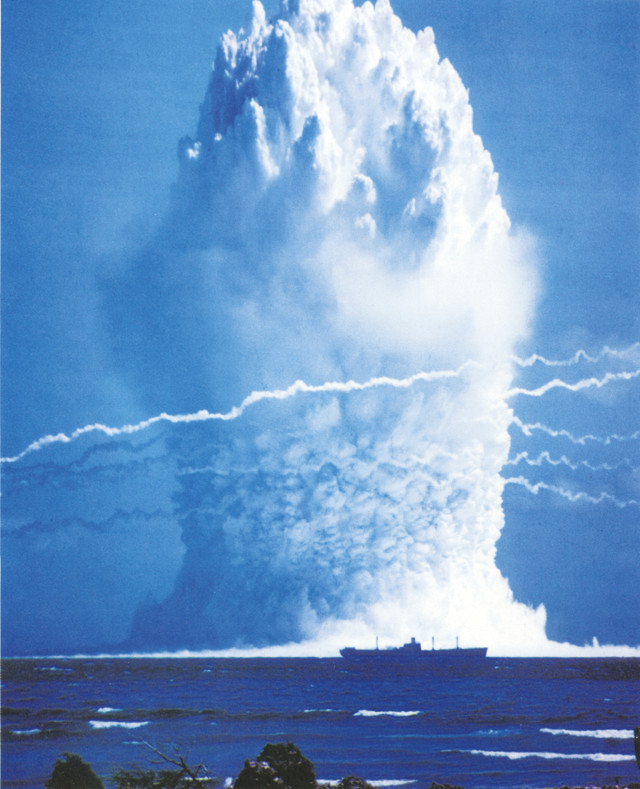
The underwater nuclear weapons test dubbed
So much of science these days is about connections and multitasking. And nowhere is this more true perhaps than with the widespread instrument networks that keep watch for the often faint sounds of impending danger, whether natural or human-made.
With the potentially high stakes of missing warning signs ahead of a disaster, individual countries and multinational consortia have increasingly turned to monitoring systems for some advance notice. But catastrophes are infrequent, and building, coordinating and maintaining multi-instrument networks — in which more eyes (or ears or noses) are almost always better than fewer — is expensive and technically challenging. So, most are now implemented with additional uses in mind beyond monitoring.
For example, the more than 4,000 seismometers that contribute to Japan’s earthquake early-warning system — implemented in 2007 and tested mightily during the calamitous magnitude-9 Tohoku quake in March 2011 — also collect data that can be used to study seismic activity of all kinds. Similarly, dozens of sea-bottom sensors and surface buoys comprising tsunami warning systems in the Pacific and Indian oceans also regularly report seismicity, as well as sea-level data, which may be useful in oceanographic and climate research.
Another example, on an even larger scale, is the globe-spanning instrument array set up under the Comprehensive Nuclear-Test-Ban Treaty (CTBT), first signed by more than 100 nations in 1996, which bans all nuclear weapons testing. Since the first stations in this network officially began reporting data back to the headquarters of the Comprehensive Nuclear-Test-Ban Treaty Organization (CTBTO) in Vienna, Austria, in 2000, the network has steadily expanded.
Today, about 85 percent of the envisioned network of 337 seismic, hydroacoustic, infrasound and radionuclide detecting stations worldwide have been installed, tested and certified — enough for the network to fulfill its main function. A series of nuclear tests conducted by North Korea in the past decade demonstrated the network’s ability to detect signatures and confirm the location of blasts.
“Our mission is to contribute, as we can, to make this world safe and secure,” says CTBTO executive secretary Lassina Zerbo. “We’ve put together a deterrent that makes sure today that no nuclear test explosion relevant to the development of a nuclear weapon would go undetected.”
And beyond showing would-be weapons testers that they can’t hide their activities, the wealth of global monitoring data produced is being put to work elsewhere — from monitoring meteorites and volcanic eruptions to nuclear reactor accidents and sea life.
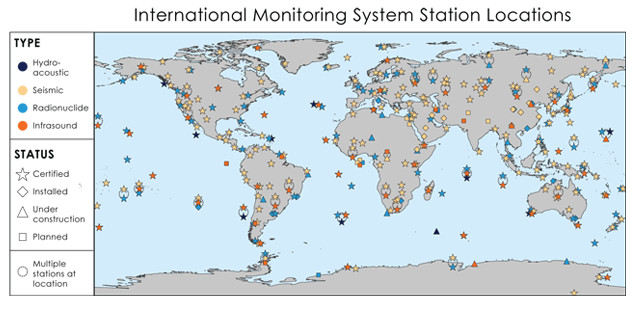
redit: K. Cantner, AGI.
In the early aftermath of the Cold War, nonproliferation proponents seized the opportunity to bring the international community together to build on past agreements, including the Partial Test-Ban Treaty (PTBT) and the Treaty on the Non-Proliferation of Nuclear Weapons (NPT). Although these had been in force since 1963 and 1970, respectively (and the NPT still is), they were only partly effective in eliminating nuclear testing. The PTBT, for example, only banned tests underwater, in the atmosphere and in outer space, pushing future tests underground.
Following several years of negotiations, a finalized comprehensive treaty — intended to outlaw all nuclear weapons testing — was brought to the United Nations General Assembly and opened for signing in September 1996. To date, 183 countries have signed onto the CTBT as member states; 164 of those have also ratified it.
In addition to detailing the terms of the test ban, the treaty laid out the structure of an international body — deemed essential to the CTBT’s efficacy — capable of independently monitoring compliance. This organization, formally known as the Preparatory Commission for the CTBTO, includes the provisional technical secretariat, which is tasked with developing and operating the CTBTO’s “verification regime”: the instruments, personnel and protocols it uses to detect, verify and report potential evidence of nuclear tests to member states.
The verification regime consists of three main branches: the International Monitoring System (IMS), the International Data Center (IDC) and an on-site inspection regime ([see sidebar]). Preparing the verification regime to reliably monitor for nuclear explosions was expected to last three years. Now, “we’re nearly 20 years down the line — we’ve done the preparatory work, we’ve proven that we can verify compliance with the treaty,” Zerbo says.
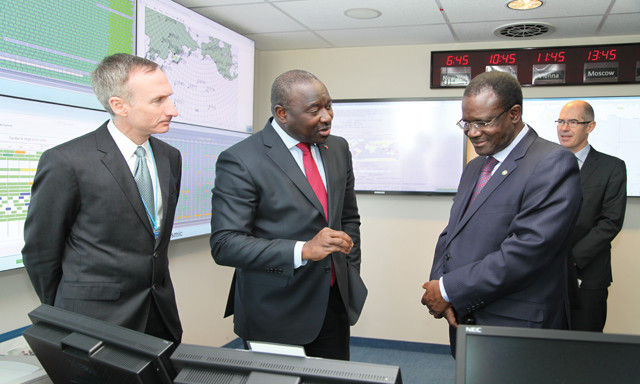
International Data Center (IDC) director Randy Bell (far left) and CTBTO executive secretary Lassina Zerbo (second from left) speak with Kadré Désiré Ouédraogo, president of the Economic Community of West African States in the IDC's operations center. Credit: ©CTBTO Preparatory Commission, CC BY 2.0.
There’s just one problem: The treaty has yet to enter into force, meaning any sanctions or other attempted penalties meted out by the international community based on CTBTO monitoring to those who break compliance cannot be legally imposed under the treaty. Entry into force requires that 44 specific countries, the so-called “Annex 2 States” that possessed some form of nuclear technology as of 1996, all ratify it. Of those, eight have not: China, Egypt, Iran, Israel and the United States have signed but not ratified it, whereas India, North Korea and Pakistan have done neither.
But the delay hasn’t kept the CTBTO from pursuing its role as a multilateral watchdog. With the majority of its global network of instruments up and running, “we’re basically operating the network … as if we were into force,” Zerbo says.
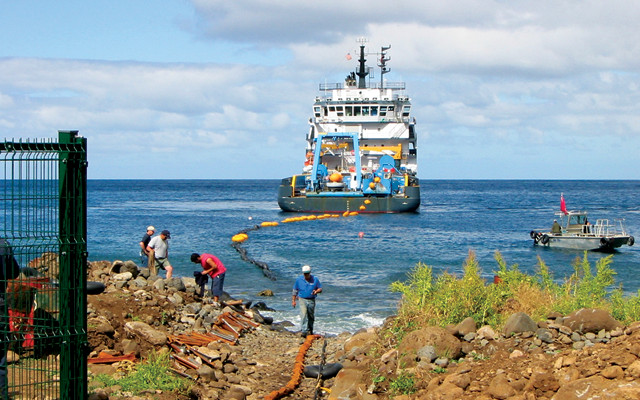
Underwater cable is installed to connect hydroacoustic sensors to the recording station on land in the Juan Fernández Islands off Chile in 2003. Credit: ©CTBTO Preparatory Commission, CC BY 2.0.
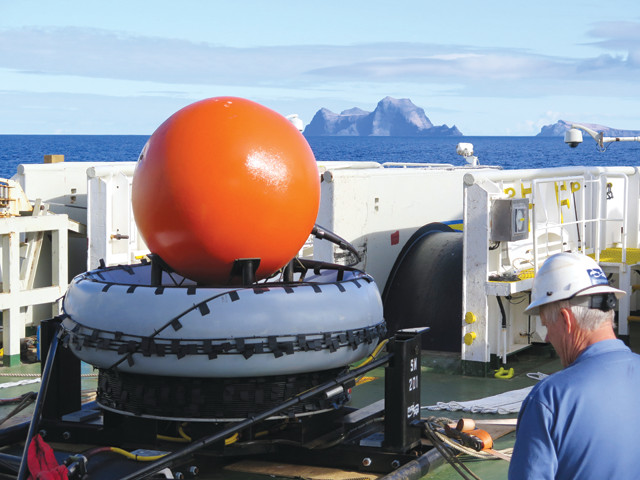
A hydrophone node waits to be deployed during efforts in 2014 to repair the Juan Fernández station. Credit: ©CTBTO Preparatory Commission, CC BY 2.0.
Four global instrument networks, designed to continuously monitor for hints of a nuclear explosion, make up the IMS, which serves as the front line of the CTBTO’s verification regime. The largest of these networks is currently made up of about 150 seismic stations (out of 170 planned) with an ear to the ground to listen for vibrations potentially generated by a blast. Like other seismometers, these instruments record the intensity, frequency and incoming direction of seismic waves traveling through Earth’s interior and across its surface. Because of the high speeds of seismic waves, these stations offer the IMS’s most rapid detection method, capable of detecting events within seconds to tens of minutes depending on an event’s size and proximity.
In addition to its seismic network, the IMS employs two additional “waveform” methods, which detect sound waves traveling underwater and in the atmosphere. Just 10 (of a planned 11) stations — located on and offshore of islands in the Atlantic, Indian and Pacific oceans — currently constitute the IMS’s hydroacoustic network, making it the system’s smallest. But because sound travels through water very efficiently, particularly through a layer of seawater about 1 kilometer below the surface that is specifically monitored by hydrophones, this group of stations still offers worldwide coverage of the oceans.
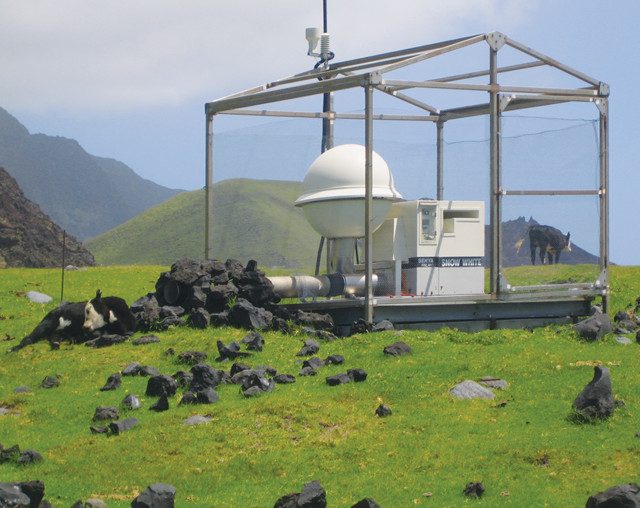
The radionuclide station on the South Atlantic island of Tristan da Cunha is equipped to measure both radioactive particulates and noble gases. Credit: ©CTBTO Preparatory Commission, CC BY 2.0.
Meanwhile, 48 stations (of a planned 60) scattered across the oceans and continents monitor the skies for low-frequency infrasound produced by volcanoes, earthquakes, aurorae and other natural phenomena, as well as by aircraft, rockets and explosions of all manner. Like hydroacoustic waves, infrasound — which has frequencies below 20 hertz, roughly the minimum audible to humans — travels efficiently through the atmosphere and can circle the globe in about 40 hours. The IMS specifically monitors infrasound with frequencies between 0.02 and 4 hertz. Each IMS station hosts an array of four to 15 microbarometers, often spread over several square kilometers, which pick up the tiny variations in air pressure associated with infrasound waves.
Together, the seismic, hydroacoustic and infrasound networks offer ample coverage of the planet to detect the sound and shaking that would accompany a nuclear explosion. In many cases, an event is likely to be picked up by at least two of the networks, says CTBTO seismo-acoustic officer and infrasound specialist Pierrick Mialle, but not always. In the case of an aboveground test, “infrasound might be the only waveform technology to pick up” a clear signal, he notes, so having all three offers valuable redundancy.
These three networks are further complemented by another, capable of sensing the radioactive fallout from a nuclear explosion. Detecting fallout is a comparatively slow and low-resolution method for determining when and where an explosion may have occurred. However, it offers unique evidence — in the form of radioactive isotopes, or radionuclides — not available from the other technologies that an event was indeed nuclear in nature. Known proportions of the radionuclides barium-140 and cesium-137, among others, are produced by nuclear fission of uranium or plutonium atoms during a nuclear explosion, explains Ted Bowyer, a nuclear physicist at Pacific Northwest National Laboratory in Washington state and chair of the radionuclide experts panel that works with CTBTO.
When released to the atmosphere, Bowyer says, most of these radionuclides latch onto dust particles and are then wafted around the atmosphere at the whim of global wind patterns. To monitor for these radioactive particles, the IMS currently has 63 stations worldwide (of a planned 80 stations) routinely collecting air samples and searching for the telltale gamma-rays they emit. Eleven separate radionuclide laboratories (with five additional labs awaiting certification) also periodically analyze samples to provide quality assurance for the 63 stations, 22 of which are further equipped to detect radioactive noble gases produced in explosions, chiefly xenon.
Unlike most radionuclides, which tend to react chemically with their environments, the noble gases are inert. “So, if you have an underground detonation … the most likely things to escape are those elements that are not reactive, and xenon is one of those,” Bowyer says, which makes it very useful in nuclear monitoring.
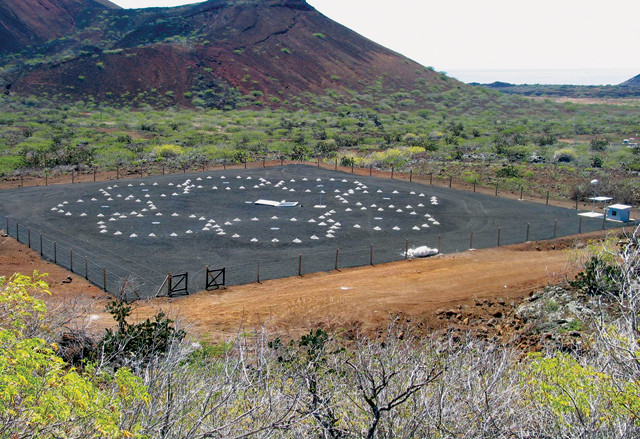
An array of infrasound detectors comprises part of the IMS station on Ascension Island in the South Atlantic Ocean. Credit: ©CTBTO Preparatory Commission, CC BY 2.0.
On the receiving end of the 10 to 15 gigabytes of data amassed each day is the IDC, located at CTBTO headquarters in Vienna. Here, a staff of about 100 works to analyze data; improve methods and advance scientific understanding of the geophysical and geochemical phenomena relevant to monitoring; liaise with member states; maintain the IDC’s communications and operate its computer networks, as well as the more than 280 IMS stations, each of which is owned and staffed by the member states.
“What we’re really aiming for is continuous high sensitivity of the entire network,” so no corner of the globe ever goes unmonitored, says IDC director Randy Bell. However, he says, “integrating the data from the four different detection methods is a challenge.” Thus, there are several stages of data processing and analysis. Computer algorithms first identify signals of seismic or acoustic origin — in the case of the waveform technologies — in individual station data, and then correlate signals from multiple stations to refine estimated timings, locations and sizes of detected events. Analysts review these automated event lists, correcting and amending them if signals have been misdiagnosed (or are simply missing) to produce daily “reviewed event bulletins.” Similarly, daily radiation reports from radionuclide stations are first reviewed automatically, then by radionuclide specialists.
In any given day, Bell says, IDC analysts review roughly 100 to 300 new events, most of seismic origin, although some days the tally tops 1,000. Making sense of all of these events is complicated by the fact that the different types of signals travel at different speeds and are detected at different times. “While a seismic signal might propagate around the Earth and be recorded here and processed all within [hours],” he says, “we then have to integrate data that’s late arriving, such as the radionuclide data,” which may come in days or even weeks after the event that produced the corresponding seismic signals.
Beyond reviewing events, the IDC also screens out those events likely to have been caused by natural phenomena from potentially human-induced events based on distinctive features in the detected signals. The character of seismic waves produced by an underground event offers clues to its origin, for example, as does its depth (seismic waves emanating from great depths can’t be anthropogenic given the limits of drilling technology). Similarly, certain kinds of hydroacoustic signals are thought to be produced only by earthquakes, thus ruling out a human origin.
But separating the natural from the potentially anthropogenic is as far as the IDC goes. “We don’t decide whether an event is nuclear or non-nuclear in nature,” Bell says. “The job of the CTBTO … is to operate the network, and receive, gather, store, process and disseminate the data,” he says. “Determination of whether a violation of the treaty has occurred is a decision left to the member states.”
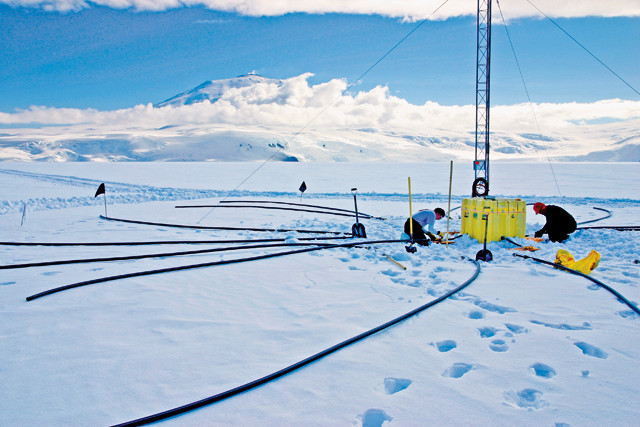
Technicians take care of maintenance on the infrasound station at Windless Bight on Ross Island in Antarctica. Credit: ©CTBTO Preparatory Commission, CC BY 2.0.
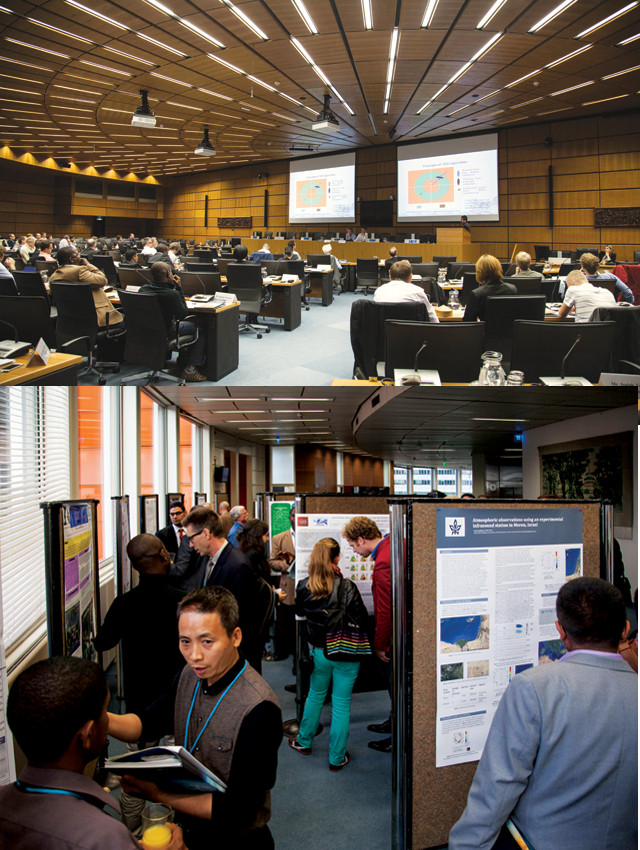
In addition to its biannual conferences, CTBTO also hosts topical workshops, including one on infrasound technology in 2014 that was attended by about 100 scientists. Credit: both: ©CTBTO Preparatory Commission, CC BY 2.0.
Since the treaty was first signed, three nuclear weapons tests — in 2006, 2009 and 2013 — have occurred, all conducted underground by North Korea. Because the CTBT was not in force, these weren’t treaty violations strictly speaking, and thus, technically, no determinations were made based on IMS data. But that doesn’t mean the explosions went unnoticed.
Seismicity originating from each of the tests was picked up at dozens of the network’s seismic stations. The most recent explosion, on Feb. 12, 2013, was also heard by regional infrasound stations. The first IMS data following the 2013 event were made available to member states within hours, according to a CTBTO press release. Further confirmation came weeks later when an IMS radionuclide station detected radioactive xenon in the air over Takasaki, Japan. Atmospheric transport modeling suggested that the timing and location of the gas’s emission likely coincided with the test.
These results have “absolutely” demonstrated the CTBTO’s ability to fulfill its intended purpose, says Zerbo, who was a research geophysicist in the mining industry prior to joining the CTBTO in 2004. And other recent events have further shown its promise, he adds. The 2011 Tohoku earthquake off Japan’s coast, for example, put all four of the IMS’s monitoring technologies to use: The earthquake and ensuing tsunami “were well-detected by our seismic and hydroacoustic stations,” Zerbo says. “Then the infrasound stations detected the explosion of the [Fukushima Daiichi] nuclear power plant itself, and our radionuclide technology followed the dispersion of radioisotopes around the globe.”
In fact, the IMS detects many other natural and human-induced activities on a regular basis, from numerous earthquakes to whale sounds to relatively small, nonnuclear explosions. Radionuclide stations have detected spikes in atmospheric cesium-137 linked to forest fires burning trees that had taken up the element following the 1986 Chernobyl reactor meltdown. The infrasound network, meanwhile, can hear volcanoes erupting thousands of kilometers away, Mialle says, and on Feb. 15, 2013 (coincidentally just three days after North Korea’s nuclear test), it picked up its largest event to date when a stunning meteor tore across the sky over Chelyabinsk, Russia.
CTBTO scientists could tell early on “that it was quite likely to be a bolide because we could see the direction of [infrasound] arrival was changing,” at the stations closest to where it passed, Mialle says. For several days afterward, the infrasound signal made laps around the planet. “For instance, in Alaska, we saw the detections from this meteorite arriving three times,” he says. “It was quite exciting.”
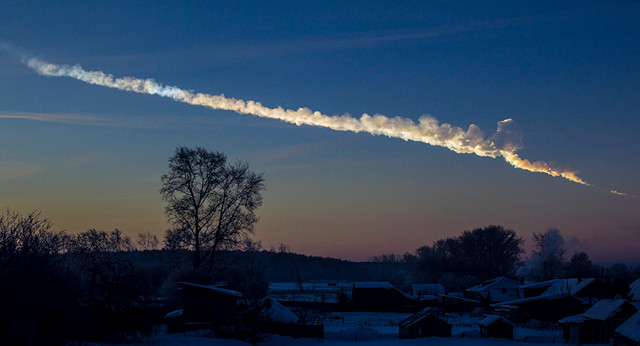
The meteor that tore across the sky over Chelyabinsk, Russia, in early 2013 was the largest event picked up to date by the IMS's global infrasound network. Credit: ©Alex Alishevskikh, CC BY-SA 2.0.
While these recent cases may have established the CTBTO’s technical abilities, IMS instruments were not the only ones to detect them. North Korea’s nuclear tests, the Chelyabinsk meteor, and the Tohoku earthquake and tsunami were detected by numerous other instruments; and radioactive emissions — at least in the latter case — were picked up by radionuclide stations outside the IMS. Some countries, like the U.S., also maintain their own nuclear test monitoring capabilities, raising questions about the added benefit of the CTBTO to member states footing its budget, about $126 million for 2015.
There is “incredible value” in having an international monitoring system “to complement the national capability,” says Bell, who, before coming to the CTBTO, directed the U.S. National Nuclear Security Administration’s (NNSA) Nuclear Detonation Detection office from 2004 to 2013. (The Nuclear Detonation Detection office is part of NNSA’s Defense Nuclear Nonproliferation Research and Development branch, which, for comparison, has a 2015 fiscal year budget of $393 million.) Foremost, he says, is that all of the CTBTO’s operations and records are transparent and available to all member states, many of which lack the resources to conduct their own monitoring. Beyond that, there is a “common trust and understanding of the international data,” Bell says, which also offers value to developed countries “when it comes to engaging in international diplomacy.”
“The CTBTO has the virtue of being a truly international clearinghouse of information,” says William Potter, director of the James Martin Center for Nonproliferation Studies in Monterey, Calif. That, combined with “its technical, as opposed to political, orientation,” lends its data and analyses great credibility on the world stage.
The IMS is also more expansive than most national monitoring networks and offers an economy of scale, Bell says. He notes that while only about 10 percent of the operational IMS stations are located in the U.S., for example, the country has access to data from all of the other IMS stations as well.
However, global coverage comes at the expense of station density and network sensitivity. Nationally operated verification networks offer more detailed local and regional monitoring than the IMS, says Terry Wallace, a forensic seismologist and the principal associate director for global security at Los Alamos National Laboratory in New Mexico. And the U.S. and other developed nations will always look first to their own capabilities and intelligence to satisfy their verification interests, Wallace says. Nonetheless, the IMS’s widespread distribution is its biggest benefit, because it has a presence “in every neighborhood” and is not targeted at particular regions or countries, he says. “CTBTO provides a confidence level to the large number of signatories … that somebody is watching out” all around the world.
The usefulness of the IMS for civil and scientific applications is another bonus, Bell says. Sharing its data for uses other than its immediate mandate wasn’t always part of the CTBTO’s rationale, however. “There was concern years ago that the data were for test monitoring purposes only and shouldn’t be used for anything else,” he says.
Then came the catastrophic Indian Ocean tsunami in 2004 — estimated to have claimed more than 200,000 lives — which was picked up by IMS sensors. “Very quickly thereafter,” Bell says, “the member states recognized that the data should be used for societal good.” Following that event, CTBTO established collaborations with tsunami warning centers, laying the groundwork for additional partnerships.
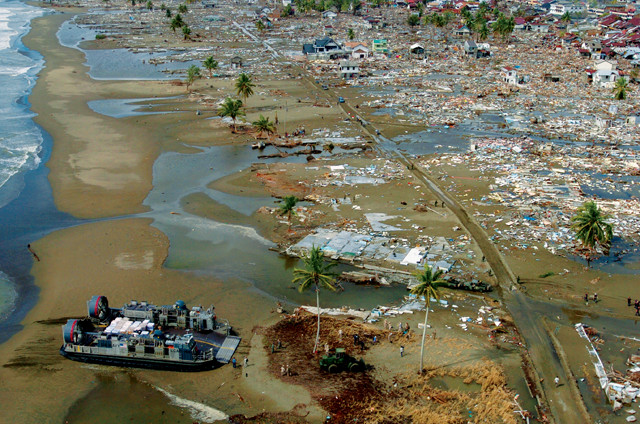
The 2004 Indian Ocean tsunami, which caused widespread devastation to coastal areas (including on Sumatra, as seen here), helped convince CTBTO member states that the organization's monitoring data should be put to use for purposes other than just nuclear test monitoring. Credit: U.S. Navy photo by Mate 1st Class Bart A. Bauer.
Mialle says that infrasound monitoring offers some of the most fertile ground for collaboration because it’s a young technology with an expanding base of researchers interested in it. In particular, he notes, there is growing interest — on the part of the International Civil Aviation Organization especially — in using the IMS’s infrasound technology in conjunction with volcanic ash advisory centers worldwide. “Not all volcanoes are well monitored, and they are looking for ways to identify when eruptions occur,” Mialle says, so they can predict when ash clouds hazardous to air traffic may appear and how they’ll move through the atmosphere.
In recent years, the CTBTO has further sought to broaden the IMS’s applicability by opening up its data to scientists and engineers outside the IDC and member state-sanctioned national data centers. Researchers must first submit proposals requesting specific datasets, and if approved, they are provided access at no cost. This has allowed many scientists to use the data “to engage in a variety of science, everything from marine mammal science to climate change, atmospheric and meteorological modeling, bolide [analysis], seismic analysis,” and more, Bell says.
Researchers, particularly in seismology, have long shared data with peers, Wallace says. But, historically, few standards existed to ensure that the quality of this data, and the methods used to process and apply it — to study Earth’s internal structure, for example — were consistent and comparable. The community-building among international scientists fostered by the CTBTO has had a “big impact” on building these standards, he says. Overall, it has “been an incredibly good exercise for lifting the entire world’s monitoring capabilities.”
And the data sharing isn’t “some sort of altruism or feel-good exercise,” Bell adds; the data are provided free of charge, but the IDC benefits from the outside innovation. “What may be noise [in the data] to me could be a valuable signal” to other researchers, he says. And if someone develops “better algorithms and mechanisms to find their signal in my noise, then I can use those same algorithms and methods to … look deeper into the data to find smaller and smaller events of interest to nuclear test monitoring.”
Considering the strained diplomatic relations among some of the nations that have not yet ratified it, the CTBT’s entry into force, in the near future at least, appears to face long odds. Potter says he’s “not optimistic that most of the remaining Annex 2 States will alter their positions anytime soon.” This includes the U.S. in his view, “notwithstanding the remarkable technical achievements the CTBTO has made.”
But “we’re making progress,” Zerbo says, noting that in early 2014 China permitted IMS stations built on its soil to begin transmitting data to the IDC, “a big step” and a possible sign it’s warming to the treaty (although these stations have not yet been fully certified by or integrated into the IMS). And despite not having ratified the treaty, the U.S. has continued to provide “strong support,” both technically and financially, he says. Moreover, additional non-Annex 2 States have continued ratifying the treaty, most recently Angola in March.
“If I didn’t think or hope that it would enter into force, I wouldn’t have run for the position [of executive secretary] to start with,” Zerbo says. “Anybody who wants to do this type of thing, you allow yourself to dream … and you want to take up the challenge.”
While the diplomatic push for entry into force continues, “our biggest challenge is to operate the infrastructure we have, maintain it, and then create a framework to sustain … this infrastructure,” he says, “which is now a more-than-$1-billion investment by the international community.”
Part of the path to sustainability involves encouraging further innovation with IMS data, both within the IDC and externally. To that end, CTBTO hosts discipline-specific workshops to bring groups of specialists together, as well as broader biannual conferences (the next takes place in June in Vienna). These meetings bring specialists together to “cross-pollinate ideas,” and give the organization a chance to “harvest all of these ideas so we can make our systems better,” Bell says. “We’re looking at improvements in every single area where we work.”
For instance, there’s an effort to refine seismic event locations and timings by improving models for calculating velocities of seismic waves traveling through different parts of the planet. In the infrasound realm, the IDC is looking to improve station designs to cut down ambient wind noise, and is also working — as part of its collaborations with ARISE (Atmospheric dynamics Research InfraStructure in Europe) — to better understand the structure and behavior of Earth’s middle atmospheric layers. The atmosphere imparts its own dynamic character on infrasound signals — attenuating or strengthening them, and altering signal directions and shapes depending on the particular conditions — meaning its behavior is important for IMS’s monitoring, Mialle says.
As the IMS continues adding stations, researchers are also “learning more about things that we didn’t know of when we first hypothesized the density of stations necessary to do adequate verification for the treaty,” Bowyer says. For radionuclide monitoring, he says the most important realization has been that background radioactivity worldwide has changed in the last couple of decades, largely due to growth in medical isotope production for cancer treatments and other procedures. Characterizing the evolution of background atmospheric radioactivity around the globe, and working with the medical isotope production community to mitigate its interference with nuclear test monitoring, are ongoing efforts, he says.
Meanwhile, the organization is working to expand the scope of its technological partnerships even farther, Zerbo says. Last fall, for example, he met with representatives from the business and scientific information technology communities to see how they could potentially make use of things like automated big-data mining and even mobile apps to advance their nuclear test monitoring capability. These efforts won’t all pan out or happen overnight, he says, but “I’m trying to dream right now.”
© 2008-2021. All rights reserved. Any copying, redistribution or retransmission of any of the contents of this service without the expressed written permission of the American Geosciences Institute is expressly prohibited. Click here for all copyright requests.